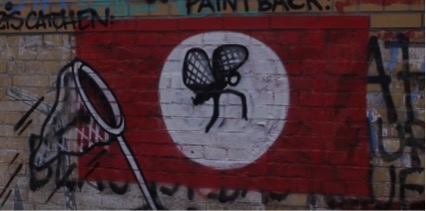
Graffiti swastikas covered with art
by Yair Frid, onUncategorized , October 29, 2017

by Yair Frid, onUncategorized , October 29, 2017
A new way to deal with anti-Semitism vandalism has risen, swastikas painted in public spaces are being creatively covered, just another alternative to graffiti removal. It all started in Germany, with a street-art collective from Berlin called Paintback.
The idea came from artist Ibo Omari, who owns a graffiti supply store in Berlin, it was there when one of his customers, not a regular one, bought some graffiti supplies and since he did not look like a graffiti artist, Omari decided to ask why he needed them, and the man said to cover a swastika painted on a children’s playground. The answer shocked Omari because he had not seen the symbol for around 20 years.
Omari and another artist that was in the shop decided to help the man to cover the symbol and came up with the idea to respond to hateful displays with humour and love. The images that they have been using to cover swastikas include animals, flowers, insects and even Rubik’s cubes.
The artists are using simple designs with the purpose to allow young people like kids and teens to participate in the covering of the offensive symbol. Klemens Reichelt, a 17-year-old who helps to cover them, said that it is very easy to have new ideas to paint over symbols and that they don’t belong in Berlin anymore so he wants to defend that.
Last year Omari and other collaborators made a short video to show the world what they are doing, which has helped to spread this concept to other cities around the world, including the U.S. where sadly there has been an increase of swastikas painted on playgrounds, walls, floors and doors. Last May, six cars were vandalised with the symbol in one of the parking lots of the University of Denver.
But the racist movement not only has been gaining steam in the U.S., also in Germany with the influx of refugees, white nationalists have been increasing the violent crimes against racial, ethnic and religious minorities. According to Amnesty International, these kind of crimes increased by 87% from 2013 to 2015. Although, swastikas are illegal in Germany since the fall of the Third Reich, Omari estimates that they have covered up around 20 of them in the past year, a number that can be considered low, but he points out that even one is too many. That is why it is important that offensive graffiti is removed as soon as possible, because one can lead to many other acts of vandalism, especially when the tag is racist or offensive.